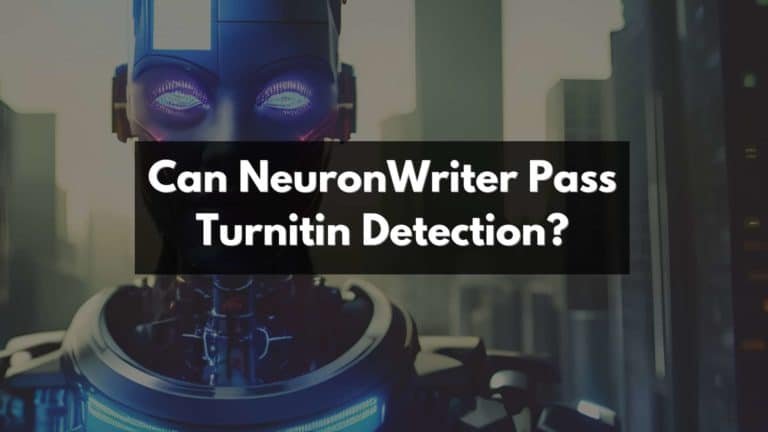Can Wordtune Pass Originality.ai Detection?
Does your AI-powered writing tool leave no trace? With the growth of AI in content creation, this question is more relevant than ever. Wordtune is an artificial intelligence-driven word processor that’s stirring up some curiosity — can it elude detection by Originality.ai, a leading text analysis software? Our exploration unravels how these advanced tools interact and unlocks strategies for maintaining originality in your work.
Ready to dig into the truth about AI-written prose? Let’s dive right in!
Key Takeaways
- Wordtune, an AI – powered writing tool, raises questions about its ability to pass detection by Originality.ai, a leading text analysis software.
- Plagiarism can be intentional or unintentional, and it is crucial for content creators to understand and avoid both types when using tools like Wordtune.
- Strategies such as using a citation system, developing a note-taking habit, and mastering effective paraphrasing can help users of Wordtune avoid plagiarism.
- The effectiveness of Wordtune in passing Originality.ai detection remains uncertain due to advancements in AI writing detection capabilities. Users should exercise caution and prioritize authenticity in their work.
Understanding Plagiarism and Wordtune
Plagiarism can be both intentional and unintentional, and Wordtune is an AI-powered writing tool that raises questions about its potential to pass Originality.ai detection.
Intentional and unintentional plagiarism
In the sphere of content creation, plagiarism represents a cardinal sin that comes in two distinct forms – intentional and unintentional. Intentional plagiarism is when someone willingly copy-pastes another’s work without giving due credit, manipulating the trust that readers place in originality.
It’s a blatant act with potential legal repercussions. On the other side of the coin, we have unintentional plagiarism which tends to be more innocent but no less damaging. This occurs when individuals unknowingly include someone else’s words or ideas into their own work, often as a result of poor citation practices or mistaken belief that the information is common knowledge.
In an era where AI-powered writing tools like Wordtune are gaining traction, understanding these two types of plagiarism becomes vital for every content creator who values authenticity and credibility.
How Wordtune works
Wordtune is an AI-powered writing tool that assists users in enhancing their content. It works by utilizing advanced language processing and text analysis techniques to provide suggestions for improving grammar, style, and overall clarity.
With its machine learning capabilities, Wordtune can generate alternative phrasing options and help users paraphrase sentences effectively.
However, when it comes to bypassing AI content detection systems like Originality.ai, the effectiveness of Wordtune becomes uncertain. While it offers valuable assistance in refining your writing skills and ensuring quality output, it’s important to note that AI content detectors are becoming increasingly sophisticated in identifying artificially generated text.
Turnitin’s Originality system, for example, employs advanced algorithms to differentiate between human-written content and AI-generated text.
Therefore, while Wordtune can certainly enhance your writing abilities and make your content more polished, its ability to completely evade detection by powerful AI systems like Originality.ai remains unclear.
Strategies to Avoid Plagiarism with Wordtune
To avoid plagiarism when using Wordtune, it is important to implement strategies such as using a citation system, developing a note-taking habit, and mastering the skill of effective paraphrasing.
Use a citation system
To avoid plagiarism when using Wordtune or any AI content writing tool, it is crucial to use a citation system. Here’s why it’s important:
- Giving credit: Properly citing sources ensures that you give credit to the original authors or creators of the information you include in your content. This includes direct quotes, paraphrases, and summaries.
- Academic integrity: If you’re a student or academic writer, citing your sources demonstrates academic integrity and upholds ethical standards. It shows that you have conducted thorough research and are using reputable sources to support your arguments.
- Avoiding plagiarism accusations: Using a citation system helps you avoid unintentional plagiarism by providing transparency about where your ideas and information come from. It allows readers or evaluators to verify the accuracy and validity of your statements.
- Building credibility: By citing authoritative sources, you strengthen the credibility of your own work. It shows that you have consulted experts in the field and adds weight to your arguments.
- Consistency and organization: A citation system helps maintain consistency and organization in your writing by providing clear guidelines for how to format citations (e.g., APA, MLA) and create a bibliography or reference list.
Develop a note-taking habit
To avoid any potential issues with plagiarism when using Wordtune or any AI content writing tool, it is essential to develop a note-taking habit. This simple practice can help you stay organized and ensure that you properly attribute any information or ideas you gather from various sources. Here are some key steps to follow:
- Start by creating a dedicated document or notebook for your notes. This will allow you to keep all your research in one place and easily refer back to it when needed.
- When conducting research, be sure to jot down the source of each piece of information you find. Include the author’s name, title of the article or book, publication date, and page numbers if applicable.
- Take detailed notes rather than copying entire passages verbatim. Summarize the main points and ideas in your own words while still capturing the essence of the original source.
- Clearly label any direct quotes by using quotation marks and noting the page number from which they were taken. This will make it easier to distinguish your own writing from quoted material.
- Avoid relying too heavily on one source by seeking out multiple perspectives and incorporating a variety of reputable references into your notes.
- Review your notes regularly as you work on your writing projects to ensure that you’re accurately representing the information from each source in your own words.
Learn to paraphrase effectively
Paraphrasing effectively is a crucial skill to avoid plagiarism and bypass AI content detection. Here are some tips to help you master the art of paraphrasing:
- Understand the original text: Before attempting to paraphrase, make sure you fully grasp the meaning and ideas conveyed in the original content.
- Use different words and sentence structures: Instead of copying the original words verbatim, rephrase them using synonyms, alternative phrasing, and varied sentence structures.
- Change the order and structure: Rearrange the information presented in the original text to create a fresh perspective. This will help you avoid direct replication while maintaining the essence of the content.
- Focus on the main ideas: Identify the key points and concepts in the original text, then express them in your own words. By focusing on these essential elements, you can put a unique spin on the information.
- Maintain clarity and coherence: Ensure that your paraphrased version retains clarity and logical flow. Avoid making changes that could alter or obscure the original meaning.
- Attribute credit when necessary: If a specific idea or concept cannot be expressed differently without losing its essence, consider including proper attribution to acknowledge its source.
The Effectiveness of Wordtune in Passing Originality. ai Detection
Wordtune’s effectiveness in passing Originality.ai detection remains uncertain, as the capabilities of AI writing detection tools continue to evolve.
Analysis of AI writing detection capabilities
AI writing detection capabilities have significantly advanced in recent years, with tools like Turnitin and Originality.ai utilizing machine learning algorithms to identify instances of AI-generated text.
These systems can effectively differentiate between human-written content and artificial intelligence-generated content by leveraging natural language understanding and analysis techniques.
By detecting patterns, linguistic oddities, and inconsistencies in the text, these AI-powered detectors can accurately identify content that has been generated by an AI writing tool.
However, it is important to note that not all AI-generated text will be flagged as plagiarism. Some sophisticated AI writing tools, like Wordtune, have developed strategies to mimic human-like writing styles and paraphrase sentences effectively.
While these techniques may make it more challenging for automated detection systems to identify the use of an AI tool like Wordtune, the ultimate effectiveness depends on various factors such as the complexity of the text or the specific algorithm being used for detection.
Potential limitations and false positives
It is important to consider the potential limitations and false positives when using an AI content writing tool like Wordtune in relation to bypassing AI content detection. While Wordtune may offer valuable assistance in improving your writing and avoiding plagiarism, it is not foolproof.
The effectiveness of its ability to pass Originality.ai detection or other AI content detectors can vary depending on several factors. These factors include the sophistication of the AI detection tool being used, such as Google’s NLG algorithms or Turnitin’s plagiarism checker, both equipped with advanced machine learning capabilities.
Additionally, while Wordtune can assist in paraphrasing techniques and enhancing your writing, it does not guarantee complete immunity from detection by these tools. It is crucial to be aware that relying solely on AI-generated content can have negative consequences if detected by search engines or academic institutions utilizing advanced systems like Turnitin’s Originality system.
Wrapping Up
In conclusion, the effectiveness of Wordtune in passing Originality.ai detection remains uncertain. While Wordtune is a powerful AI-powered writing tool, it is important to remember that AI content detectors have made significant advancements in detecting artificially generated text.
Google’s NLG and machine learning algorithms can identify AI-generated content, and Turnitin’s plagiarism detection system also incorporates AI technology.
It is crucial for users of Wordtune and similar tools to understand the potential limitations and risks associated with using them to bypass AI content detection. The consequences of utilizing easily detectable AI-generated content can be severe, especially in academic settings where plagiarism is heavily penalized.
Ultimately, individuals seeking to avoid plagiarism should prioritize developing strong paraphrasing skills, utilizing proper citation systems, and practicing effective note-taking habits.
These strategies can help ensure originality in their written work without relying solely on AI-powered tools like Wordtune.
While Wordtune may provide valuable assistance as a grammar checker and writing enhancement tool, it is recommended to exercise caution when attempting to evade or manipulate AI content detection systems.
Conclusion
In conclusion, the effectiveness of Wordtune in passing Originality.ai detection remains uncertain. While AI content detectors have shown proficiency in identifying AI-generated text, it is unclear whether Wordtune can successfully evade detection.
As a precaution, students and content creators should prioritize originality and utilize reliable citation systems to avoid unintentional plagiarism.
FAQs
1. Can Wordtune pass Originality.ai detection?
Wordtune is a tool that helps enhance and rewrite text, but it does not guarantee or claim to be undetectable by plagiarism detection software such as Originality.ai.
2. Will using Wordtune result in plagiarized content?
Using Wordtune alone doesn’t mean you will automatically produce plagiarized content. However, if the original source material is copied without proper attribution or if the rewritten content closely resembles another person’s work, it could still be considered plagiarism.
3. How can I ensure my writing remains original when using Wordtune?
To maintain originality when using tools like Wordtune, it’s essential to use them as aids and not rely solely on them for creating content. Always double-check the rewritten text for any similarities with existing sources and properly attribute ideas from external references.
4. Are there any limitations to detecting rephrased text by technology like Originality.ai?
While plagiarism detection technologies have advanced significantly, they may still struggle to identify subtly reworded or paraphrased content accurately. However, relying on this limitation intentionally would disregard ethical standards surrounding intellectual property rights and academic integrity.





